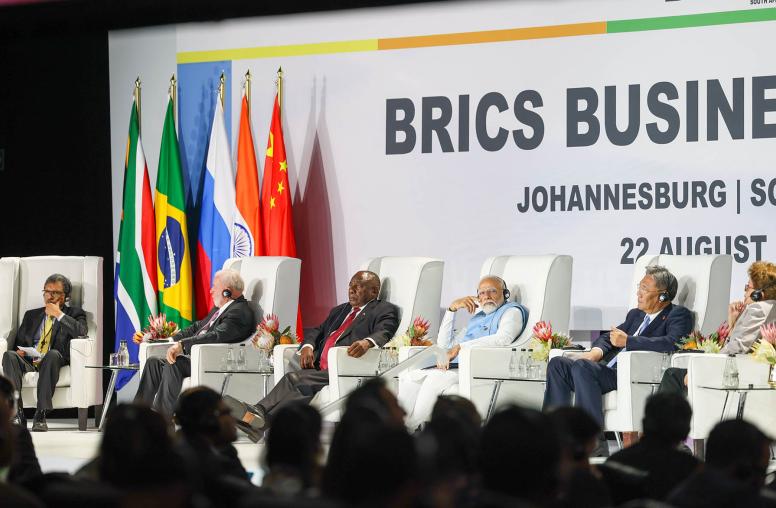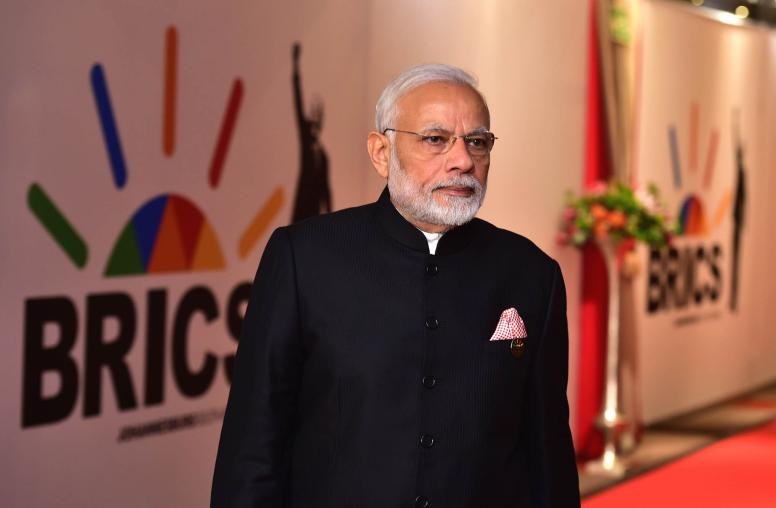As Fragile Kashmir Cease-Fire Turns Three, Here’s How to Keep it Alive
Reinstating diplomatic ties, enhancing trade will be key to preserving the fragile truce between India and Pakistan.
At midnight on the night of February 24-25, 2021, India and Pakistan reinstated a cease-fire that covered their security forces operating “along the Line of Control (LOC) and all other sectors” in Kashmir, the disputed territory that has been at the center of the India-Pakistan conflict since 1947. While the third anniversary of that agreement is a notable landmark in the history of India-Pakistan cease-fires, the 2021 cease-fire is fragile and needs bolstering to be maintained.

This anniversary occurs at a momentous time in the politics of both South Asian countries. Pakistan conducted national elections on February 8, 2024. India prepares for national elections that are mandated constitutionally no later than this summer. Indian Prime Minister Narendra Modi visited Jammu, the winter capital of the Indian union territory of Jammu and Kashmir, on February 20, and India’s Supreme Court has also directed that local elections should be held there no later than September of this year.
A new USIP Special Report, “The 2021 India-Pakistan Ceasefire: Origins, Prospects, and Lessons Learned,” finds the confluence of these tumultuous political forces augurs a period of uncertainty for the India-Pakistan relationship that may jeopardize a cease-fire that has thus far provided a stabilizing effect and allowed Indian and Pakistani leaders to focus on other pressing needs within their respective countries.
The Origins of the 2021 Cease-Fire
The agreement to reinstate a cease-fire in Kashmir was reached following an especially contentious time in India-Pakistan relations. Roughly two years before the cease-fire, both Asian nuclear powers had conducted air strikes on each other in February 2019 — the first time one nuclear-armed state had used airpower on the territory of another nuclear-armed state. In August 2019, India downgraded the constitutional status of the only Muslim-majority state of Jammu and Kashmir within the Indian system. Fearing a social mobilization against the move, India substantially increased its security force presence in the territory, restricted telecommunications in the region and detained Kashmiri politicians and activists. This, in turn, led Pakistan’s then prime minister, Imran Khan, to compare Modi’s India to Nazi Germany.
In addition to these military and rhetorical escalations, firing along Kashmir’s disputed boundaries worsened. India records every episode of firing in its tally of “cease-fire violations” that it reports publicly. Each violation in this tally might only entail a few rounds of small arms fire or it might encompass large volleys of artillery shells across the LOC. Yet even this imprecise measure showed a period of heightened violence and tensions in Kashmir. While 2018 had more than 2,000 recorded violations, Indian records show nearly 3,500 violations in 2019 and over 5,000 such violations in 2020. Despite over 600 violations in the first 54 days of 2021, the reinstated cease-fire on the night of February 24 brought the incidents almost to a total stop. In the subsequent years, there have only been a few isolated incidents of firing between the security forces India and Pakistan deploy to protect their frontiers in Kashmir.
The cease-fire has been a remarkable, albeit limited, success. It is remarkable because it has largely resulted in the cessation of firing along the Line of Control. Hundreds of thousands of families live close enough to Kashmir’s contested boundaries to be vulnerable during firing. They may be displaced, injured or killed when cross-frontier violence worsens. The cease-fire is remarkable as well because it has endured while most political, diplomatic and economic ties have ceased between India and Pakistan since 2019. This additional fact helps underscore the cease-fire’s limitations. It has not kickstarted broader rapprochement between India and Pakistan.
Both its successes and limitations become more apparent when compared to prior attempts to cease firing within Kashmir. The 2021 cease-fire has endured when several other attempted cease-fires (in 2000-2001, 2013 and 2018) proved ineffective or short-lived. Since the modern Kashmir insurgency began in 1989, only one cease-fire agreement (in 2003) generated a more enduring reduction in violence across the Line of Control. That 2003 cease-fire also proved long-lasting. It did not collapse suddenly, but rather frayed into meaninglessness so it is hard to date its ending precisely. But the 2003 cease-fire largely held with just single-digit tallies of annual violations recorded by India through 2006, and still fewer than 100 violations through 2011.
Yet that 2003 cease-fire also highlights the limitations of the current one. Alongside that earlier cease-fire, India and Pakistan also explored wide-ranging backchannel talks to resolve bilateral disputes and irritants. New Delhi additionally engaged in political outreach to Kashmiri separatists within Indian-administered Kashmir to consider their grievances while also taking advantage of reduced violence in Kashmir to redeploy forces in an attempt to improve civilian livelihood. That progress largely halted or was reversed as violence worsened from 2008 onward. It is impossible to know if back-channel talks have made meaningful progress since the 2021 cease-fire agreement, but there are few signs that they have.
Why Cease-Fires Hold… and How they Collapse
In seeking to understand why some cease-fires fail and others endure, two features appear to be associated with success. The first is senior leader buy-in that lessening tensions in Kashmir is wise. Leaders often have doubts if they face serious power struggles internally or if they worry about perceptions of weakness especially in advance of elections. Leaders may also have preexisting ideological views about the other side that are slow to change. A second motivating feature is the presence of a heightened third-party threat. For the 2003 cease-fire, Pakistani and Indian leaders were willing to consider rapprochement, and the growing danger of terrorism in Pakistan appears to have shifted the views of the Pakistani Army regarding the urgency of that need. For the 2021 cease-fire, while evidence is still incomplete, there are signs that the Pakistani Army had been interested in conciliation with India under then army chief Gen. Qamar Javed Bajwa, and this interest was reciprocated in the form of the Kashmir cease-fire only after the violent 2020 Sino-Indian clashes provided a powerful strategic incentive for Indian leaders to overcome their distrust of the Pakistan military.
Similarly, these features help explain the collapse of the 2003 cease-fire. With the late Pakistani President Pervez Musharraf’s weakening political hold, the back-channel talks were unable to convert their optimistic discussions into other concrete deliverables. Additionally, with a first debilitated and then displaced Musharraf, leader buy-in to confront anti-India Islamist groups attenuated in Pakistan. After Musharraf’s departure from office, the Pakistan military and intelligence agencies apparently did not prevent — and may have facilitated — an attack by terrorists on Mumbai in November 2008. This attack weakened then Indian Prime Minister Manmohan Singh’s control of foreign policy in India. With domestic political tumult in Pakistan and Singh’s incomplete grip on power in India, neither India nor Pakistan were able to prevent the steady deterioration in their relationship that manifested in part through worsening violence in Kashmir. That violence, in turn, contributed to the appeal of Modi, who became prime minister in 2014 on a platform of steadfastness in confronting India’s enemies and commitment to good governance at home.
The Cease-Fire’s Fragility and Steps to Bolster It
The tumult of contemporary South Asian politics may endanger the cease-fire. Already, the cease-fire is one of the few examples of Indo-Pakistani rapprochement since the twin crises of 2019. Both countries have little trade, anemic people-to-people exchanges and even downgraded diplomatic relations. While the cease-fire endures, there are signs adherence to it is beginning to slacken. In the last six months, there have been at least four episodes of small arms or mortar fire along the boundary that separates Indian-administered Jammu and Kashmir from Pakistan’s Punjab state. (The Line of Control divides Indian- and Pakistani-administered Kashmir, but since India does not claim Pakistan’s Punjab it calls the boundary between Kashmir and Punjab the international border. Since Pakistan claims Kashmir it calls the boundary the working boundary.)
This uptick in cease-fire violations is especially worrisome because they occur at a time when we have reason to doubt leader buy-in. In Pakistan, there is political confusion in the civilian government following the February 8 elections. Additionally, the army chief under whom the cease-fire was negotiated, Bajwa, left office in November 2022. His successor, Gen. Asim Munir, does not have a reputation as an India hawk, but nor does he appear as interested in rapprochement as Bajwa was. In India, Modi continues to enjoy high popularity, but his government too is preparing for elections where he will be wary of appearing timid when it comes to Pakistan.
Both states appear to have hoped they might defer difficult choices until the political milestones of 2024 had passed them. This may not be possible. A long period of political uncertainty seems probable in Islamabad. If India waits for national elections to be finished in the summer and then waits further for local elections in Kashmir by the fall, even more time will be lost. The cease-fire will be vulnerable to external and internal shocks.
As hard as it might appear, it is useful to begin a conversation about a positive agenda to bolster the cease-fire and to complement it. This includes laying the groundwork for a resumption of broader diplomatic ties, including reinstating ambassador-rank representatives in each other’s capitals. (India and Pakistan, as members of the Commonwealth, call these senior-most representatives high commissioners, rather than ambassador as is employed for the equivalent position outside the Commonwealth.)
Thinking through the obstacles to more normal trade relations, either across the Line of Control in Kashmir or more broadly between India and Pakistan, might help jump-start long-stalled negotiations. Identifying low-hanging military confidence-building measures elsewhere outside of Kashmir might also help show that the cease-fire can complement progress elsewhere, such as along the Sir Creek estuary near the disputed India-Pakistan maritime boundary, or covering the Siachen Glacier beyond the northern demarcation of the Line of Control.
Waiting for the ideal moment to begin building a positive agenda for cooperation carries with it the very real danger that the cease-fire will break down and the broader relationship will relapse into crisis or conflict. Both India and Pakistan face too many other challenges to divert resources indefinitely to their conflict. Yet the conflict will not end through quiet inaction. It will take positive steps to build barriers between the status quo and open hostility.
Christopher Clary is an associate professor of political science at the University at Albany, State University of New York and author of The Difficult Politics of Peace: Rivalry in Modern South Asia (Oxford University Press, 2022).



